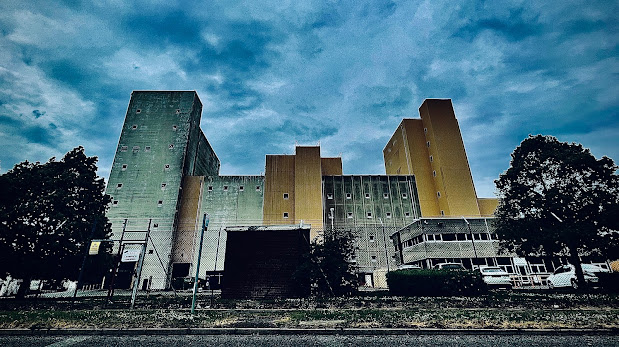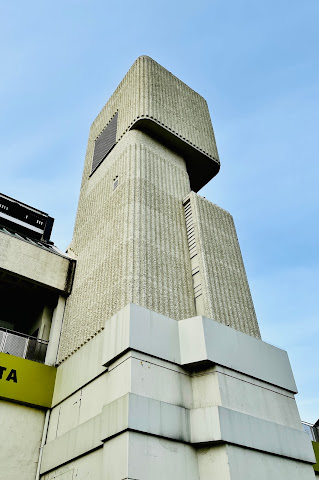 |
| Corby’s magnificent Flour Mill on the Earlstrees Industrial Estate. A future Tate Modern I shouldn’t wonder. |
It's a sad fact that many of the buildings in our otherwise historic towns and cities are really not much to look at when viewed at street level. Whilst historic buildings survive all over the country, and great archectecture and design can be found just about eveywhere, the blight of featureless modern steel, plastic, and plate glass shop fronts mean you often have to look-up from street level to actually find it.
 |
| Civic Pride: The impressive former Strathclyde Hotel, reflected in Corby's equally impressive Cube |
Because it's this ground floor vista that's suffered the most. The beautiful tile, timber and stained glass shop frontages of old have for the most part simply gone, replaced by cheap, bland frontages designed solely for the purpose of showing the fashion and foodie goods that lie within. In so doing they've made many of our high streets messy, boring, and frankly a bit depressing to wander around. Is it any wonder grafitti abounds!...
I've been
looking-up in town centres for decades now, the view from the roof down often a marvel of
Victorian opulence or stylish
Deco design. Now you might imagine that a town as freshly minted as Corby would offer slim pickings for the vertically inquisitive visitor, but there's plenty to see if you know where to look, particularly if it's late 20th Century architecture you're looking for, which is the coolest of all civic and commercial design trends I'm sure you'll agree.
In fact some of the style of yesteryear remains at ground level, as can be seen at the corner of
Welland Vale and
Willow Brook Roads (
above). Classic 60's (?) municipal tilework, the attractive end-stop to a row of neighbourhood shops and takeaways with their associated first floor flats. This unique '
Gaudi-esque' survivor is free to view, and very handy for the weekly shop. It's also within a
Corby Roll's throw of the similarly attractive
Shire Horse pub.
The iconic
Clock Tower isn't much of a tower, and sadly the clock stopped working many years ago, but it is an icon of the town and rather beautiful I'd say. From what I can gather the starry blue dial rotated slowly at all times, and the clock struck the hour, quite loudly by all accounts (the bell can be seen in the top half of the tower if you look carefully). Although a Twitter colleague of mine recalls that they were silenced between the hours of 11pm and 7am so as not to disturb the residents in flats below. Corby is of course very busy organising its once-in-twenty-years
Pole Fair at the moment, but if there were one thing that might garner popular support as a
Jubilee Year project, could it be getting the marvellous Clock Tower restored and working again? I think so!
Another of Corby's stopped clocks, this one handily set at opening time for the nearby
Corby Candle pub (hint: the Candle is
always open!). But note the frieze running along the length of the otherwise unremarkable
Edinburgh House. This is the kind of unobtrusive urban art we might walk past every day for years and never notice. As you can see it features the two images most strongly associated with Corby, a
Raven with a Shovel, and a
Steelworks Cauldron, representing Corby's heritage both ancient (the
Corvid) and modern (
Ironstone Extraction and
Steel Working).
Big thanks to local journalist
Kate Cronin for drawing my attention to this impressive
Corby Town edifice. Driven past dozens of times and never noticed, now impossible to un-see!
Has your town got one of these? I can only suggest you petition your council at the earliest opportunity, and don't worry if there isn't a multi-story car park or shopping centre to go with it, if they build it, these will surely come.
Who knew the humble lift shaft could be so brutally fabulous! I've never been inside the concrete structure though! I feel it would only spoil the pleasure, a mere stairwell could never live up to the towering majesty of its impressive exterior.
Within clear view of the
Saxon Crown pub on
Elizabeth Street, this potent symbol of the British justice system pierces the skyline like some kind of mighty sword skewering a crown, which indeed it does. I say potent, the
Magistrates Court that this spikey finial sits atop has been closed for business since 2016, and how long the building will last in its current form (it's not a 'looker' in truth) is anyone's guess. A late 1950's build designed by
A.N Harris of the
County Architects Dept, it's to be hoped that the distinctive roof furniture at the very least will find an appropriate home somewhere in Corby, but just in case, do go see it before it succumbs to the innevitable damage or decay...

The rush to throw up housing for the influx of Steelworkers in the post-war years has left Corby with an unusually high number of what's known as 'non-traditional housing', two examples of which can be seen on a wander along Willow Brook Road. 'Wates' houses are distinguished by their squareform sectional walls, constructed from interlinking pre-cast concrete panels. Although many are now being retro-fitted with a more traditional brick cladding, numerous untouched examples survive in Corby.
The house seen here is a 'British Iron and Steel Federation' (BISF) construction, consisting of a Steel frame with rendered cladding and timber weatherboarding to the upper floor. This one obviously needs a bit of a spruce up, but the missing boards give a good idea of the novel design. I've featured this one in particular, rather than one of the many well-maintained examples nearby, because it's up for sale. In case you're interested...
 |
| Looking up not necessary, just look across the road from the Candle or Saxon Crown |
Can you believe the fabulous (former)
Anglican Church of the Epiphany & St John in Corby Town Centre isn't listed and protected to high heaven!
I know!!! Grade II at least by my reckoning, but being a late 20th Century build these beautiful modernist buildings routinely slip through the net when it comes to official appreciation and protection.
A Donald F. Martin-Smith Architect building completed in 1962, the church seems to have closed as a place of worship in 2011, and remains empty and possibly under threat of neglect at the very least. A real shame as the unusual geometry of the building creates an equally impressive high ceilinged and well-lit interior.
So we can't go inside now, but a wander around the outside of the building reveals a series of four beautiful glazed tile friezes (right), depicting the three Magi bearing gifts to the baby Jesus. Honestly! Someone please get this building listed.














Comments
Post a Comment